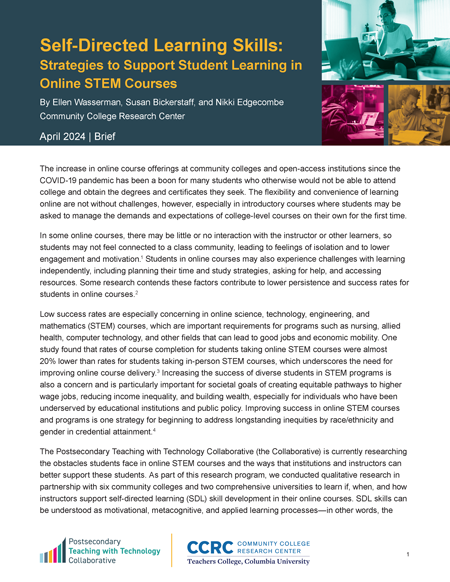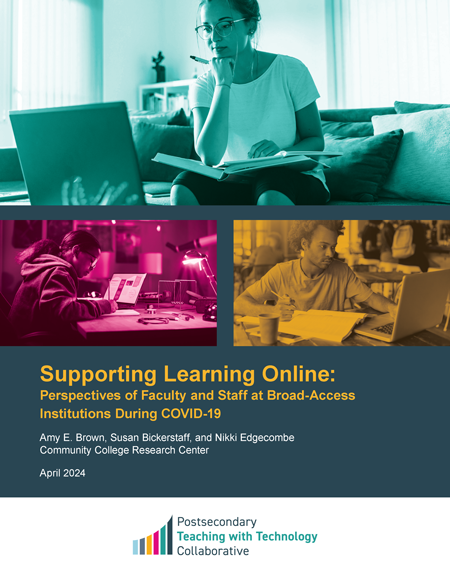April 26, 2024 | By Amy E. Brown and Ellen Wasserman
With the huge growth in online courses since the start of the COVID-19 pandemic, faculty are increasingly aware that they need to adapt their teaching to the new environment of online instruction. But they may not know how to adapt and, in particular, how to support students’ skills in managing their own learning in online courses.
To learn effectively in online courses, students benefit from having a set of attitudes and dispositions—such as motivation—and learning skills—such as planning, help seeking, and reflection—that we call self-directed learning (SDL) skills. The Collaborative’s research is grounded in the idea that these skills and attitudes work together to set students up for success in their courses.
The Collaborative recently released two publications that provide concrete examples of SDL skill support at community colleges and broad-access universities and highlight practices relevant to STEM disciplines.
The first is a brief on faculty teaching practices called Self-Directed Learning Skills: Strategies to Support Student Learning in Online STEM Courses, and the second is a report on institution- and classroom-level supports for online teaching and learning and SDL skills called Supporting Learning Online: Perspectives of Faculty and Staff at Broad-Access Institutions During COVID-19. In this blog, we summarize key points in these publications to showcase how the Collaborative’s partner institutions support students’ motivational, metacognitive, and applied learning processes and identify challenges and opportunities to bolster and institutionalize SDL supports for students in online STEM courses.
The brief draws upon data from a survey of 141 biology and math faculty at eight of the Collaborative’s partner institutions and 12 virtual “course tours” with STEM instructors who walked researchers through the structure and content of their online courses by sharing their screens in Zoom. The report draws upon data from virtual interviews and focus groups conducted in 2021 and 2022 with 139 stakeholders (including deans, faculty development coordinators, instructional designers, and faculty) at all nine of the Collaborative’s partner institutions to learn more about institutional priorities and initiatives related to online instruction and promoting students’ SDL skills. Taken together, this research shows that broad-access postsecondary institutions have many strengths to draw on to support students’ SDL development in online courses.
With many more students taking online courses since COVID-19, broad-access institutions bolstered online teaching and learning supports and online course development and design infrastructure.
In the midst of the COVID-19 pandemic, most institutions made changes to improve conditions for online teaching and learning, including improved use of learning management systems, increased professional development for instructors, improved technology infrastructure and expanded software licenses, and the development of student-facing online orientation materials.
Most faculty and staff agreed that SDL skills are important and that institutions should work to help students strengthen and develop these skills.
The publications highlight several strategies implemented at the course and institution levels that show promise for bolstering students’ SDL skills and improving student success. For example, in a synchronous eight-week online biology course at a community college, the instructor incorporated teaching strategies intended to boost students’ motivation and sense of belonging. Students created short weekly video reflections using Flip Video technology. These low-stakes assignments used a rose–thorn–bud framework where students described what was going well (the rose), what was challenging (the thorn), and what they found promising in their strategies (the bud). Students shared their videos with their peers and the instructor on the course site in the learning management system. The instructor reported that the video exchange deepened connections between him and his students and built a sense of belonging among the students as they got to know each other and share common experiences.
Common institution-level supports for SDL include first-year orientations, success courses, and affinity group programming. It was less common to find an initiative aimed at supporting SDL in multiple online courses or course sections. One notable exception is the STAR (Successful Transition to the Academic Realm) program at Virginia State University. Faculty and staff in the STAR program worked to develop, implement, and study evidence-based approaches to build VSU undergraduate students’ STEM identity, resilience, and self-efficacy and to prepare them for STEM graduate programs and careers. One of the classroom activities developed through the STAR program is a class-period-long presentation delivered near the start of the term to teach students how to apply metacognitive learning strategies, how to develop a growth mindset, how to use a study cycle, and how to increase their self-confidence. The presentation also helps students think about how to manage, plan, and block out time needed to support their own learning. Most faculty break up the class-period-long presentation into segments that they teach throughout the first half of the term, starting with metacognition and time management topics, and reinforce important strategies throughout the course. Faculty across the university are supported to implement this activity in their courses. These strategies, combined with peer mentoring and supplemental-instruction tutoring, contributed to increases in course pass rates for biology majors during the first iteration of the program.
Faculty would benefit from more professional development to support SDL instructional strategies.
Along with these promising examples, our two publications point to challenges to implementing SDL supports for students in online courses. While most faculty and staff we interviewed said that SDL skills are important and should be supported by the institution, explicit instructional support for SDL skills inside classrooms appears to be limited and uneven. Faculty may not know how to teach these skills, may not think that they have the time or resources to do so, or may not see it as their responsibility. Nearly 20% of faculty we surveyed were not aware of the idea of SDL, and another third reported lacking the training and information to incorporate it into their practice. Common barriers that faculty said prevent them from supporting these skills in their courses include insufficient time in their course designs to incorporate more content or activities, the greater urgency of other areas of instruction, and lack of latitude to make changes due to course requirements. In spite of these individual and institutional efforts, faculty continue to see poorer student performance, communication, and engagement in online courses and seek proactive ways to enhance the quality of online learning. Our research underscores the need to build awareness of the promise of SDL skills in support student success in online STEM courses.
Related Publications
- Self-Directed Learning Skills: Strategies to Support Student Learning in Online STEM Courses
- Supporting Learning Online: Perspectives of Faculty and Staff at Broad-Access Institutions During COVID-19
![]() Sign up to get the latest news from the Collaborative delivered to your inbox
Sign up to get the latest news from the Collaborative delivered to your inbox
Tags: Online Learning Postsecondary Learning Self-directed Learning

